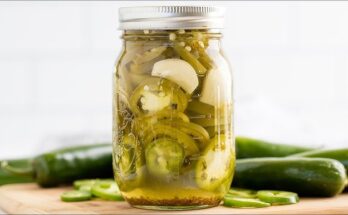Boneless Prime Rib Roast Recipe: There’s nothing quite as mouthwatering or celebratory as a beautifully cooked boneless prime rib roast. It’s the star of the table—whether you’re hosting a holiday dinner, celebrating with family, or just treating yourself to an indulgent homemade meal.
This guide will walk you through everything, from picking the best cut to the final slice, with expert-level tips to help even first-timers roast like a pro.
Why Choose Boneless Over Bone-In?
This debate comes up often: bone-in or boneless? While bone-in rib roasts are classic and dramatic on the plate, boneless prime rib has its own distinct advantages. First and foremost—convenience. Boneless is easier to carve and cooks a bit more evenly. There’s no need to navigate around bones when slicing, making it a popular choice for home cooks who want simplicity without compromising flavor.
Plus, when cooked properly, a boneless roast can be just as juicy and flavorful as its bone-in cousin. Want to keep it super tender? You can always tie the roast with butcher’s twine to maintain shape and ensure even cooking. Whether it’s your first time or your fiftieth, boneless prime rib makes the whole process more approachable and beginner-friendly.
How to Pick the Best Cut of Boneless Prime Rib
Before you even think about preheating the oven, selecting the right cut is half the battle won. Look for a well-marbled piece—the fat is what brings out the prime rib’s signature flavor and keeps it tender. Ideally, you’ll want to ask your butcher for a center-cut roast, often labeled as the “eye” of the rib. This portion tends to be the most uniform in shape and quality.
Make sure your roast is fresh (or properly thawed if frozen), deep red in color, and has a solid layer of fat cap on top. That cap renders beautifully as it roasts, basting the meat in its own juices. Aim for a USDA Prime grade if you can get it—this is the highest quality and gives that steakhouse-level tenderness and taste.
List of Ingredients You’ll Need
Getting that unforgettable prime rib flavor starts with a simple list of quality ingredients.
Prime Rib Cut
- Boneless Prime Rib Roast – 4 to 7 pounds is ideal for most families (serves 6–10 people)
Seasonings & Herbs
- Kosher salt – 2–3 tablespoons
- Fresh cracked black pepper – 1 tablespoon
- Fresh rosemary – 2 tablespoons, chopped
- Fresh thyme – 1 tablespoon, chopped
- Garlic cloves – 5–6, minced
- Olive oil or softened butter – 3 tablespoons
- Optional: Onion powder, smoked paprika, or mustard powder for added flavor
Tools and Equipment
- Roasting pan with rack
- Meat thermometer (instant-read or probe style)
- Butcher’s twine (if roast needs tying)
- Sharp carving knife
- Aluminum foil (for resting)
That’s it! No need for complex marinades or 20 different spices. A prime rib is naturally flavorful—you’re just helping those flavors shine.
Understanding the Grades of Beef (Prime vs. Choice)
Ever wondered what “Prime” in prime rib really means? It’s actually a USDA grade. There are three common grades you’ll see at grocery stores:
- Prime – Highest grade, heavily marbled, often found in steakhouses.
- Choice – Very good quality, less marbling, still tender and juicy.
- Select – Leaner, less flavorful, not recommended for a luxurious roast.
If you want that restaurant-style richness, go for USDA Prime. It’s more expensive but worth it for special occasions. Choice can still be fantastic—just consider brining or using a generous rub to boost flavor.
How Much Prime Rib Per Person?
Not sure how much to buy? A good rule of thumb:
- ½ to ¾ pound per person for boneless roast
- 1 pound per person if you want leftovers or hearty portions
For example, a 6-pound boneless prime rib roast comfortably serves 8–10 people. Always err on the side of too much—leftover prime rib is a gift that keeps on giving.
Preparing Your Boneless Prime Rib Roast
Alright, you’ve got the ingredients and you’re ready to roll up your sleeves. Let’s get that roast ready.
Trimming and Tying the Roast
If your roast has uneven thickness or is a little floppy on one side, ask your butcher to trim and tie it—or do it yourself. Use butcher’s twine every 1.5 inches along the roast to hold it together. This ensures uniform cooking and a gorgeous shape.
Room Temperature is Key
Take the roast out of the fridge at least 2 hours before roasting. Letting it come to room temperature ensures even cooking from edge to center and helps avoid overcooking the outer layer while the inside catches up.
Dry Rub vs. Marinade – Which is Better?
Prime rib doesn’t need a marinade—it’s already bursting with flavor. A dry rub made of salt, pepper, garlic, and herbs is all you need. Salt penetrates the meat, breaking down proteins for a buttery texture, while herbs and garlic create that crave-worthy crust.
Marinades can sometimes overpower the natural flavor of the beef or make the outer layer too wet, which can ruin the sear. Stick with a dry rub, rub it in generously, and let it rest uncovered in the fridge overnight for max flavor.
Step-by-Step Cooking Guide
Here’s where the magic happens. Follow these exact steps to make your roast unforgettable.
Step 1: Prepping the Roast
Start by patting the roast dry with paper towels. Dry surfaces lead to better crusts. Combine olive oil or butter with garlic, rosemary, thyme, salt, and pepper. Rub this all over the roast—top, bottom, and sides. Let it sit uncovered for 1–2 hours at room temp or refrigerate overnight for deeper flavor.
Step 2: Seasoning the Meat
Be generous. This is a big piece of meat, and it needs bold seasoning. Salt is your friend here—it draws out moisture, tenderizes, and enhances natural flavor. Crack fresh pepper just before applying it for that pungent kick.
Step 3: The Reverse Sear Method Explained
Instead of searing first, reverse it. You’ll slow-roast the beef at a low temperature first, then blast it with heat at the end. Why? You get perfectly even pink meat from edge to edge and a killer crust. This is how restaurants do it.
- Roast at 225°F (107°C) until internal temp hits 115°F for medium rare.
- Let it rest (more on that soon).
- Crank oven to 500°F (260°C) and blast the roast for 10–15 minutes to create the crust.
Step 4: Oven Cooking Time & Temperature
Let’s get specific. The goal is consistent, controlled heat to bring your boneless prime rib to the exact level of doneness you prefer. Since we’re using the reverse sear method, the initial oven temperature should be 225°F (107°C).
General Cooking Time Guide:
- For rare (120–125°F): About 20 minutes per pound
- For medium rare (130–135°F): About 25 minutes per pound
- For medium (135–140°F): About 30 minutes per pound
But don’t just rely on time—you need a meat thermometer. This is your best friend. Insert the probe into the thickest part of the roast, away from any fat or bone (even though this is boneless, fat can mislead the reading).
Once it hits your desired internal temp (for example, 120°F for rare, 125°F for medium-rare), pull it out of the oven. It will rise another 5–10 degrees while resting. If you want a crispy crust, that’s coming next in the high-heat blast.
Step 5: Resting the Meat Properly
So, you’ve pulled it from the oven. Now what? Let it rest—seriously.
This isn’t optional. Resting allows the juices to redistribute evenly throughout the roast. If you skip this step and cut into it right away, all that beautiful juice will end up on your cutting board.
Tent the roast loosely with foil and rest for at least 30–45 minutes before slicing. During this time, the internal temp will rise slightly, and the meat will settle into its final, ultra-tender state. Trust the process.
Internal Temperature Guide for Prime Rib Doneness
Here’s a quick reference chart to help you get the doneness just right. Always use a meat thermometer for accuracy:
| Doneness | Remove from Oven at | Final Temperature (After Rest) |
|---|---|---|
| Rare | 115°F (46°C) | 120–125°F (49–52°C) |
| Medium Rare | 120°F (49°C) | 130–135°F (54–57°C) |
| Medium | 130°F (54°C) | 135–140°F (57–60°C) |
| Medium Well | 140°F (60°C) | 145–150°F (63–66°C) |
| Well Done | 150°F+ (66°C+) | 160°F+ (71°C+) |
If you want that classic steakhouse finish, aim for medium-rare. It’s the sweet spot between juicy and flavorful, without being overly red or dry.
Making the Perfect Au Jus or Gravy
Let’s level up with an au jus—a light, flavorful beef sauce that pairs perfectly with prime rib.
Simple Au Jus Recipe:
Ingredients:
- 1 cup beef broth (preferably low sodium)
- ½ cup red wine (optional but delicious)
- 1 tbsp Worcestershire sauce
- 2 tbsp drippings from roast
- Salt and pepper to taste
Instructions:
- After removing the roast, place the roasting pan over medium heat on the stove.
- Add wine and scrape up the brown bits with a wooden spoon.
- Pour in broth and Worcestershire. Stir well.
- Let it simmer until slightly reduced (about 10–15 minutes).
- Season to taste and strain if desired.
This thin gravy elevates every bite. You can also thicken it slightly with a cornstarch slurry if you prefer a more traditional gravy.
Carving the Prime Rib Like a Pro
Now comes the satisfying part—slicing into that beauty. Always carve across the grain for maximum tenderness. Use a long, sharp slicing knife for clean, even cuts.
Carving Tips:
- Slice the roast into ½ to ¾ inch thick slices.
- For presentation, fan them out on a warm platter.
- Serve immediately with a drizzle of au jus or a side of horseradish cream.
Want thinner slices for sandwiches? Chill the roast first—cold meat is easier to slice thin.
What to Serve with Prime Rib – Perfect Pairings
Your roast deserves equally tasty sides. Here are some classic and creative pairings to complete your meal:
Starches:
- Creamy mashed potatoes
- Garlic roasted fingerlings
- Yorkshire pudding (traditional pairing)
- Truffle mac & cheese
Veggies:
- Roasted Brussels sprouts with balsamic glaze
- Honey-glazed carrots
- Sautéed green beans with almonds
- Creamed spinach
Sauces:
- Au jus (of course)
- Horseradish cream
- Dijon mustard
- Chimichurri (if you want a fresh, herbaceous twist)
Create a well-rounded plate and you’ll have a meal worthy of any steakhouse.
Tips for Making It Ahead of Time
Want to reduce stress? You can prep your prime rib a day in advance. Here’s how:
- Season the roast with herbs, garlic, and salt.
- Leave it uncovered in the fridge overnight. This helps dry out the surface for a better crust.
- On roast day, let it come to room temp for 2 hours before cooking.
- Roast as directed. Reheat slices later at 250°F wrapped in foil with a splash of broth.
The flavor even intensifies overnight, making this a smart move for busy holidays or dinner parties.
Common Mistakes to Avoid When Cooking Prime Rib
Even seasoned cooks make these mistakes. Here’s what to watch out for:
- Not using a thermometer – Guessing leads to overcooked meat.
- Skipping the resting step – This drains your meat of juices.
- Under-seasoning – Be bold. Salt brings out the flavor.
- Searing too early – Reverse sear gives better control.
- Cutting with the grain – Always slice across the grain.
- Cooking straight from the fridge – Let it warm up to room temp.
Stick to the method in this guide, and you’ll sidestep these pitfalls easily.
Leftover Ideas – What to Do With Extra Prime Rib
Let’s be honest—leftover prime rib is a blessing. And if you cooked more than your guests could handle, don’t just reheat and repeat. Get creative! This roast can transform into some truly epic meals.
1. Prime Rib Sandwiches
Nothing beats a thick, juicy sandwich. Thinly slice the leftover beef and layer it on a crusty baguette or ciabatta roll. Add caramelized onions, provolone cheese, and a smear of horseradish mayo. Toast it for that melty, crispy perfection.
2. Steak & Eggs Breakfast
Who says prime rib is only for dinner? Dice it up and toss it with breakfast potatoes, onions, and peppers. Top with a runny fried egg and a sprinkle of hot sauce. You’ve got yourself a five-star brunch.
3. Prime Rib Tacos
Chop the meat into small pieces and sauté with garlic, cumin, and lime juice. Serve it in warm corn tortillas with avocado, pickled onions, and cilantro for a taco night that’s anything but basic.
4. Beef Stroganoff
Turn leftover roast into a rich and creamy stroganoff. Slice into strips and toss it into a pan with mushrooms, onions, sour cream, and beef broth. Serve over egg noodles or mashed potatoes.
5. Prime Rib Fried Rice
Dice the meat and stir-fry it with rice, scrambled eggs, peas, carrots, and soy sauce. Add a splash of sesame oil for that signature takeout flavor—done in 15 minutes flat.
Leftovers never looked (or tasted) this good. Store your roast properly in an airtight container and it’ll keep in the fridge for up to 5 days—or freeze for 2–3 months.
FAQs about Boneless Prime Rib Roast Recipe
1. Can I cook a boneless prime rib in an air fryer or slow cooker?
You can, but it won’t give you that same beautiful crust or even cook. The oven (using reverse sear) remains the best method for texture and flavor. Air fryers are better for reheating slices, not cooking a whole roast.
2. What if my roast doesn’t have a fat cap?
No worries! Just rub the roast generously with olive oil or butter. You can even lay a few strips of bacon on top to mimic the fat layer and baste the roast while it cooks.
3. Should I use a roasting rack or place the roast directly in the pan?
A rack is best—it elevates the roast so heat circulates evenly and prevents the bottom from stewing in its juices. If you don’t have one, use a bed of chopped onions, carrots, and celery instead (bonus: flavorful au jus!).
4. Can I cook my prime rib from frozen?
Nope. Always thaw completely in the fridge (this can take 2–3 days for large roasts). Cooking from frozen will result in uneven cooking and potential food safety issues.
5. How do I store and reheat leftover prime rib without drying it out?
Wrap slices in foil with a splash of beef broth or au jus. Reheat at 250°F until warmed through (about 15–20 minutes). This method keeps it juicy and prevents overcooking.
Conclusion
Cooking a boneless prime rib roast at home isn’t just a recipe—it’s an experience. With a quality cut of beef, a handful of fresh herbs, and the reverse sear method, you can create a show-stopping main dish that rivals any steakhouse. Whether it’s a holiday, birthday, or “just because,” this roast turns any meal into a celebration.
From choosing the perfect cut to carving the final slice, every step in this guide is designed to help you feel confident, avoid common mistakes, and enjoy the process. And hey—if you have leftovers, that’s just tomorrow’s gourmet meal waiting to happen.
So, tie on your apron, fire up the oven, and bring the magic of prime rib to your table. You’ve got this!



